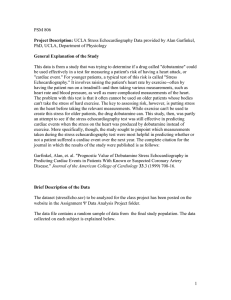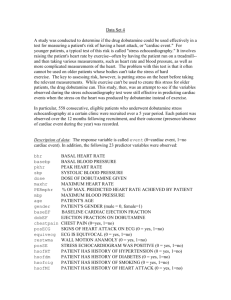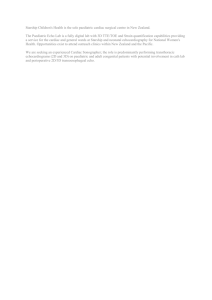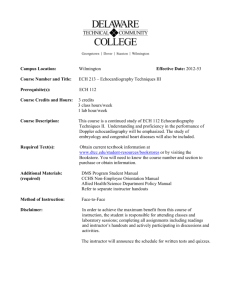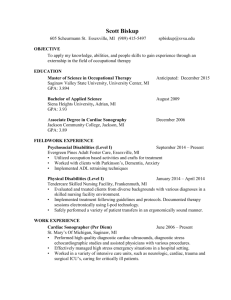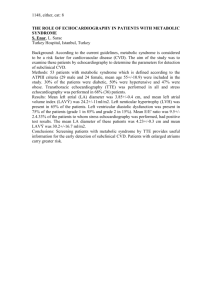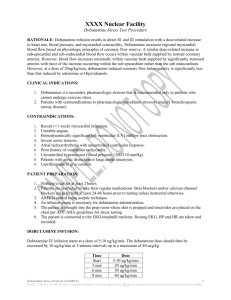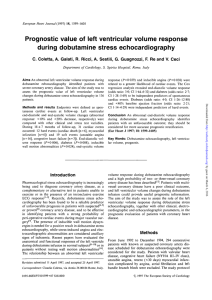TABLE OF CONTENTS
advertisement
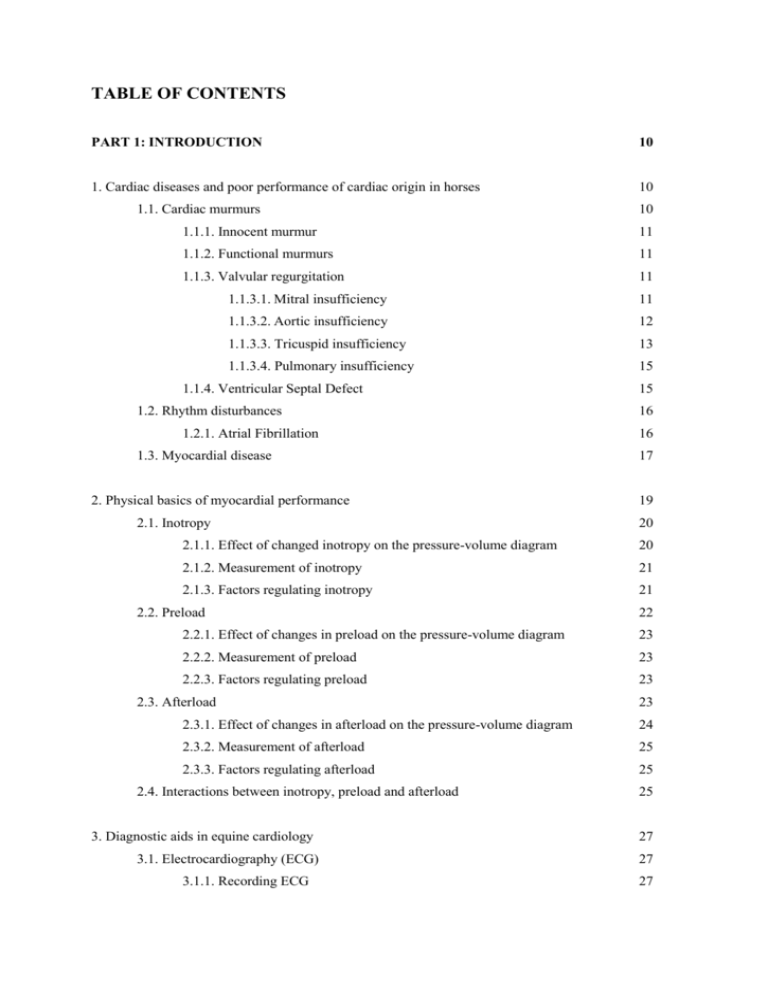
TABLE OF CONTENTS PART 1: INTRODUCTION 10 1. Cardiac diseases and poor performance of cardiac origin in horses 10 1.1. Cardiac murmurs 10 1.1.1. Innocent murmur 11 1.1.2. Functional murmurs 11 1.1.3. Valvular regurgitation 11 1.1.3.1. Mitral insufficiency 11 1.1.3.2. Aortic insufficiency 12 1.1.3.3. Tricuspid insufficiency 13 1.1.3.4. Pulmonary insufficiency 15 1.1.4. Ventricular Septal Defect 1.2. Rhythm disturbances 1.2.1. Atrial Fibrillation 1.3. Myocardial disease 2. Physical basics of myocardial performance 2.1. Inotropy 15 16 16 17 19 20 2.1.1. Effect of changed inotropy on the pressure-volume diagram 20 2.1.2. Measurement of inotropy 21 2.1.3. Factors regulating inotropy 21 2.2. Preload 22 2.2.1. Effect of changes in preload on the pressure-volume diagram 23 2.2.2. Measurement of preload 23 2.2.3. Factors regulating preload 23 2.3. Afterload 23 2.3.1. Effect of changes in afterload on the pressure-volume diagram 24 2.3.2. Measurement of afterload 25 2.3.3. Factors regulating afterload 25 2.4. Interactions between inotropy, preload and afterload 3. Diagnostic aids in equine cardiology 3.1. Electrocardiography (ECG) 3.1.1. Recording ECG 25 27 27 27 3.1.2. Interpretation of ECG 27 3.1.3. The ECG-derived Heart score 28 3.1.4. Radiotelemetry 29 3.1.5. Long-term ECG monitoring 29 3.2. Radioimaging 30 3.3. Phonocardiography 30 3.4. Biochemical markers of cardiac damage 31 3.5. Blood pressure monitoring 32 3.6. Cardiac Catheterisation 33 3.6.1. Cardiac output measurement by the Fick method 33 3.6.2. Cardiac output measurement by indicator dilution methods 34 3.6.2.1. Cardiac output measurement by dye dilution method 35 3.6.2.2. Cardiac output measurement by thermodilution method 36 3.6.3. Measurement of intracardiac pressures and pressure changes 38 3.6.4. Pulmonary capillary wedge pressure 38 3.6.5. Oxygen tension measurements 39 3.7. Echocardiography 39 3.7.1. Physical basics of diagnostic ultrasound 39 3.7.2. Clinical indications for performing an echocardiogram 42 3.7.3. Evaluation of cardiac structures by B- and M-mode echocardiography 42 3.7.3.1. Evaluation of the cardiac chambers and walls 43 3.7.3.2. Evaluation of cardiac valves 43 3.7.3.3. Evaluation of the pericardium 44 3.7.4. Evaluation of cardiac function by B- and M-mode echocardiography 44 3.7.4.1. Indices of systolic cardiac function 44 3.7.4.2. Indices of global cardiac function 45 3.7.5. Evaluation of cardiac function by Doppler echocardiography 46 3.7.5.1. Evaluation of transvalvular flows 47 3.7.5.2. Measurement of diastolic cardiac function by Doppler 47 echocardiography 3.7.5.3. Doppler-derived pressure gradients 48 3.7.5.4. Evaluation of cardiac function by Doppler echocardiography 48 3.7.6. Contrast echocardiography 50 3.7.7. Echocardiographic heart score 50 3.7.8. Doppler tissue imaging 51 3.7.9. Exercise stress echocardiography 51 4. Stress echocardiography in humans 53 4.1. Indications of stress echocardiography 53 4.2. Pathophysiology of ischemic disease detected by stress echocardiography 53 4.3. Ischemic stressors in stress echocardiography 53 4.3.1. Treadmill exercise stress test 54 4.3.2. Bicycle exercise stress test 54 4.3.3. Dobutamine stress test 54 4.3.4. Dipiridamole stress test 55 4.3.5. Electrical Pacing stress test 55 4.4. The stress test protocol 55 4.5. Interpretation of stress echocardiography 56 4.6. Accuracy of stress echocardiography for the detection of coronary artery disease 56 5. Dobutamine and atropine as modifying agents of cardiac function 5.1. Dobutamine 58 58 5.1.1. Pharmacology and pharmacokinetics of dobutamine 58 5.1.2. Mechanism of action of dobutamine 58 5.1.3. Chronotropic effect of dobutamine 59 5.1.4. Dromotropic effect of dobutamine 60 5.1.5. Lusitropic effect of dobutamine 60 5.1.6. Therapeutic use of dobutamine in human and veterinary medicine 60 5.2. Atropine 61 5.2.1. Pharmacokinetics of atropine 61 5.2.2. Atropine’s action on the heart 62 5.2.3. Atropine’s action on other organs 62 5.2.4. Therapeutic use of atropine in human and veterinary medicine 62 5.3. Combined effects of atropine and dobutamine 63 PART 2: RESEARCH OBJECTIVES 65 PART 3: SYNOPSIS OF EXPERIMENTS 67 1. Comparison of the effects of high-dose dobutamine and atropine/low-dose 67 dobutamine on cardiac output as an indicator of global left ventricular function (Study 1) 2. Effect of atropine/low-dose dobutamine stress test on left ventricular 73 echocardiographic B- and M- mode parameters in healthy horses (Study 2) 3. Comparison of exercise to pharmacological stress echocardiography in 78 healthy horses (Study 3) 4. Effect of atropine/low-dose dobutamine stress test on major determinants 84 of myocardial performance in healthy horses (Study 4) 5. Cardiac power output measurement using a dobutamine stress test in 90 healthy horses (Study 5) PART 4: GENERAL DISCUSSION, CONCLUSIONS, PERSPECTIVES 95 PART 5: REFERENCES 100 PART 6: SCIENTIFIC PAPERS 130 1. Atropine reduces dobutamine-induced side effects in ponies 131 undergoing a pharmacological stress protocol Sandersen C., Detilleux J., Delguste C., Pierard P., van Loon G., Amory H. Equine Vet. J., 2005, 37, 128-132. 2. Effect of Atropine-Dobutamine Stress Test on Left Ventricular 145 Echocardiographic Parameters in Untrained Warmblood Horses Sandersen C.F., Detilleux J., de Moffarts B., van Loon G., Amory H. Journal of Veterinary Internal Medicine 2006, 20, 575-580. 3. Exercise and pharmacological stress echocardiography in healthy horses Sandersen C., Detilleux J., Art T., Amory H. Equine Exercise Physiology 7 (Equine Vet. J. Suppl.), 2006, 36, 159-162. 159 4. Afterload and contractility during dobutamine stress test in healthy horses 172 Sandersen C., Detilleux J., Amory H. In preparation 5. Cardiac power output during dobutamine stress test in healthy horses 186 Sandersen C., McEntee K., Detilleux J., Amory H. Submitted for publication 6. Stress echocardiography in horses – a review 203 Sandersen C. and Amory H. Pferdeheilkunde 2006, 22, 609-617. PART 7: SUMMARY 224 PART 8: RÉSUMÉ 229 PART 9: INDEX OF ABBREVIATIONS 236
